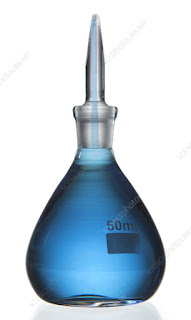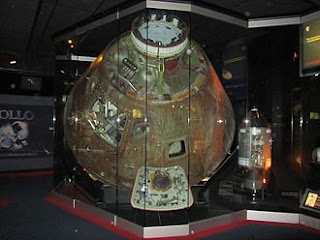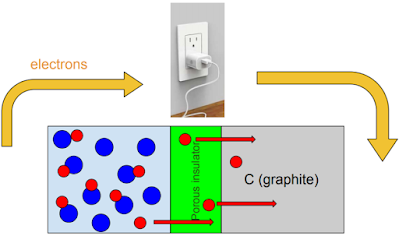Galvanic cells and batteries use chemistry to produce electricity, but the opposite is also possible. We can use electricity to drive chemistry. This process is called electrolysis and one of the reasons we do it is to break compounds down into their elements.
Electrolysis of a Pure Ionic Compound
Gold, as you probably know, is mined. This works because gold has a very low activity. As a result, it is found in pure form in nature. Sodium, near the top of the activity series, is never found in nature as a neutral element. We find compounds containing sodium inos (\(Na^{+1}\)), but never pure sodium. That means that in order to obtain pure sodium, we need to force the sodium ions to take back their electrons to become neutral.
\(Na^{+1} + e^{-1} \rightarrow Na\)
Let’s look at how this could be done. We’ll use NaCl (table salt) as the source of the sodium ions. At room temperature, NaCl is an ionic solid with the ions locked in place. To free them up to move, we’ll melt the salt. This requires a temperature above \(801^oC\) (nearly \(1500^oF\)). Once the salt has melted, the ions will be freer to move around.
We’ll then place two electrodes in the container with the molten salt.
We can then hook an external source of electricity (shown here as a dry cell).
The negative end of the dry cell is giving off electrons and the positive end is pulling them in. That means that the electrode hooked to the negative end ends up with a lot of excess electrons and the other electrode ends up positively charged (missing electrons).
Since the ions that make up NaCl are charged, they will be attracted to opposite electrodes as shown
So, what happens when those ions reach the electrodes?
When the \(Na^{+1}\) ions reach the electrode with the excess electrons, they take an electron and produce pure sodium:
\(Na^{+1} + e^{-1} \rightarrow Na\)
At the same time, when the \(Cl^{-1}\) ions reach the positive electrode, they lose an electron and become neutral. Of course, chlorine atoms ever occur alone, so this process happens to two chlorine ions to produce chlorine gas, as seen here:
\(2~Cl^{-1} \rightarrow Cl_2 + 2~e^{-1}\)
This reaction is, of course, not “natural” in the sense that the salt on your table never randomly falls apart into pure sodium and chlorine gas. That is why we needed the power source. Let’s take a closer look.
If we look up the two reactions that are occurring in our electrolytic cell on the Standard Reduction Potential Table, we find only the sodium reaction occurring as written.
\(Na^{+1} + e^{-1} \rightarrow Na~~~~~~~~~~~-2.71 V\)
The other reaction is written on the table as a reduction:
\( Cl_2 + 2~e^{-1}\rightarrow 2~Cl^{-1}~~~~~~~~~~1.36 V\)
However, since this reaction is occurring in the opposite direction (as an oxidation, rather than a reduction) we need to reverse the reaction, which will change the sign on the potential:
\(2~Cl^{-1} \rightarrow Cl_2 + 2~e^{-1}~~~~~~~~~~-1.36 V\)
Adding the two reactions together, will give us a potential of \(- 4.07 ~V\). The negative sign here tells us two things. First, that the reaction has to be pushed in order to occur, and second that the “push” required is more than 4.07 volts. In other words, to make this work, the dry cell at the top would need a voltage of at least 4.08 volts.
Electrolysis of an Aqueous Solution
You remember, from reading about solvation, that the ions in an ionic compound (like NaCl) are also free to move around when they are dissolved in water. So, you might wonder why we had to melt the table salt, rather than just dissolving it in water. It turns out, there is a really good reason.
When NaCl is dissolved in water and placed in an electrolytic cell (like the one pictured above), the same reactions are possible:
\(Na^{+1} + e^{-1} \rightarrow Na\)
\(2~Cl^{-1} \rightarrow Cl_2 + 2~e^{-1}\)
However, because water is present, there are several other reactions that are also possible. On the Standard Reduction Potential Table, there are three reactions we need to consider. Each of these reactions is relevant because they can occur with ONLY water as a reactant.
The first is about ⅓ of the way down the front side of the table:
\(2~H_2O + 2~e^{-1} \rightarrow H_2 + 2~OH^{-1}~~~~~~~~~~-0.83~V\)
The other two reactions are both on the back side of the table. Because water is a product of the reactions (as written on the table) we will need to flip each of them and then to change the sign on their voltages. The reactions, in the form we need them, are:
\(2~H_2O \rightarrow O_2 + 4~H^{+1} + 4~e^{-1}~~~~~~~~~~-1.23~V\)
\(2~H_2O \rightarrow H_2O_2 + 2~H^{+1} + 2~e^{-1}~~~~~~~~~~-1.77~V\)
All of that means that there are 5 possible reactions that can occur in our cell when we apply the external power. Those 5 reactions are:
\(Na^{+1} + e^{-1} \rightarrow Na~~~~~~~~~~-2.71~V\)
\(2~Cl^{-1} \rightarrow Cl_2 + 2~e^{-1}~~~~~~~~~~-1.36~V\)
\(2~H_2O + 2~e^{-1} \rightarrow H_2 + 2~OH^{-1}~~~~~~~~~~-0.83~V\)
\(2~H_2O \rightarrow O_2 + 4~H^{+1} + 4~e^{-1}~~~~~~~~~~-1.23~V\)
\(2~H_2O \rightarrow H_2O_2 + 2~H^{+1} + 2~e^{-1}~~~~~~~~~~-1.77~V\)
To determine which reactions actually DO occur, we need to do two things.
First, we need to separate the reactions into oxidations and reductions. This is because there MUST be one of each type of reaction for the process to work. That gives us:
\(Na^{+1} + e^{-1} \rightarrow Na~~~~~~~~~~-2.71~V\)
\(2~H_2O + 2~e^{-1} \rightarrow H_2 + 2~OH^{-1}~~~~~~~~~~-0.83~V\)
and
\(2~Cl^{-1} \rightarrow Cl_2 + 2~e^{-1}~~~~~~~~~~-1.36~V\)
\(2~H_2O \rightarrow O_2 + 4~H^{+1} + 4~e^{-1}~~~~~~~~~~-1.23~V\)
\(2~H_2O \rightarrow H_2O_2 + 2~H^{+1} + 2~e^{-1}~~~~~~~~~~-1.77~V\)
Secondly, we need to think about what those negative voltages mean. Galvanic cells always have a positive voltage. They are reactions that nature favors. Here, all of the reactions go “against nature.” However, nature is lazy. That is, the reaction that occurs will be the one which is the “least unnatural” - the one with the least negative voltage.
So, for the two reductions, the water reaction is less negative (-0.83 v -2.71) and for the three oxidations, the first water reaction is the least negative (-1.23 v -1.36 and -1.77). That means that when we electrolyze aqueous NaCl, we don’t get sodium (Na) and chlorine (\(Cl_2\)). Instead, we get hydrogen and oxygen.
\(2~H_2O + 2~e^{-1} \rightarrow H_2 + 2~OH^{-1}~~~~~~~~~~-0.83~V\)
\(2~H_2O \rightarrow O_2 + 4~H^{+1} + 4~e^{-1}~~~~~~~~~~-1.23~V\)




































